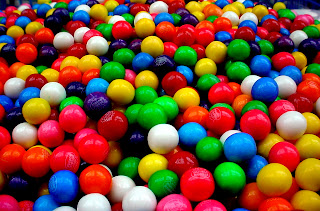What you need:
- pipe cleaners
- crafting beads
- fuzzy pom-poms
- glue dots
Instructions:
1. Have students pick an element from the first two rows of the Periodic Table of Elements.
Element: Carbon
Chemical Symbol: C
Atomic Number: 6
Atomic Weight: 12.01
3. Students will then calculate the number of protons, neutrons and electrons that make up the element they have chosen.
The atomic number is equal to the number of protons and electrons in the nucleus of an atom, and determines which element the atom is. For example, any atom that contains exactly six protons in it's nucleus is a carbon atom. The atomic weight (relative atomic mass) of an element is the ratio of the average mass of atoms of the element to 1/12 of the mass of an atom carbon-12 (unified atomic mass unit). Confusing? Lets simplify it. To calculate the number of neutrons in an atom's nucleus you need the element's mass number. You can determine this by rounding the atomic weight to the nearest whole number. In carbon's case, we round 12.01 to the whole number 12. We can now say:
Mass number = number of protons + number of neutrons
For carbon, the equation becomes:
12 = 6 + number of neutrons------> 12 - 6 = number of neutrons
Solving for the number of neutrons you should get six neutrons!
Carbon
Number of protons: 6
Number of electrons: 6
Number of neutrons: 6
3. After you have determined the number of protons, neutrons and electrons it is time to distribute the electrons in it's shells. An electron shell can be thought of as an orbit followed by electrons around an atom nucleus. Each shell can only contain a fixed number of electrons, this is referred to as electron capacity. The maximum number of electrons that can occupy a specific energy level can be found using the following equation:
Electron Capacity = 2n^2
*the variable n represents the Principal Quantum Number, the number of the energy level in question.
** ^2 signifies to the second power or squared.
In carbon's case there are six electrons. The first shell's capacity is two, therefore only two of carbon's six electrons are found in the first shell. That leaves four electrons to fit comfortably in the second shell.
4. Finally, we can start building an atom!!!! Begin by taking one pipe cleaner and making a loop at the top. This will enable you to hang you atom when it is completed.
5. Count out enough pom-poms for the number of protons and neutrons in the nucleus of your atom. For the carbon atom I counted out 6 protons and 6 neutrons.
6. Use the glue dots to piece together the nucleus of the atom.
7. Affix the nucleus to the pipe cleaner. This can be done by pushing the pipe cleaner through the center of the nucleus. Reinforce the nucleus with more glue dots.
8. We previously determined the distribution of electrons for the carbon atom. Carbon has six electrons. The first shell has a capacity of two electrons. Add two of the crafting beads to a pipe cleaner.
9. Now wrap your pipe cleaner around the nucleus of the atom to form the first shell. Secure it.
10. Repeat step 9, but for the second shell. The second shell's carrying capacity is eight. Carbon's four remaining electrons will have plenty of room:)
Enjoy your atom!!!
Resources to use in the classroom:
- This website allows your students to use an interactive simulation to build an atom.
- This website allows your students to explore the atomic structure of any atom by simply choosing an atom from a drop down menu.
Resource for the teacher:
The Disappearing Spoon is a great read for teachers that will be exploring the Periodic Table of Elements in their classroom. This book is full of interesting stories about the history and magnificence of the elements and their discoverers. Take these interesting stories to your classroom and engage your students!!!


































